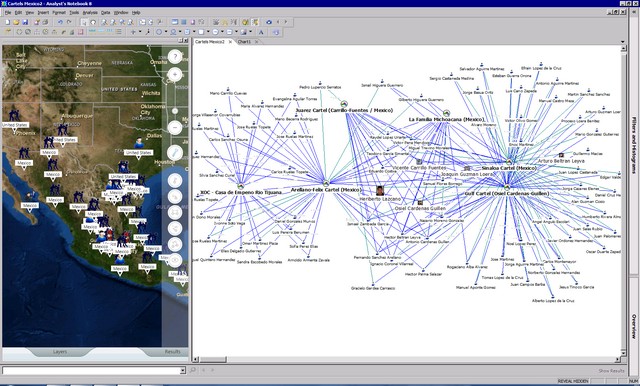More than ever, law enforcement agencies are connecting to far flung sources of information in the fight against terrorism. Now Virginia’s i2 Group is offering police departments a new tool
The company is launching an open-source database on worldwide group-based violence that gives local law agents access to a massive, searchable pool of information on terrorist groups, organized crime, and militant organizations culled from foreign language papers, chat rooms, and other frequently walled-off sources. And it’s hoping to garner interest from fusion centers, inter-agency terrorism investigation and response centers favored by local law enforcement agencies because of the generous funding they receive from the federal government. Federal agencies generally support them because they give access to otherwise-unavailable intelligence from local police departments. Despite criticism of their potential for misuse and justified fears of civil liberties violations and data mining, fusion centers are a prominent part of the American counterterrorism landscape.
I2’s fusion center software suite includes an analysis tool called iBase and a related visualization tool called Analyst’s Notebook, and it makes use of an open source database from the Institute for the Study of Violent Groups. The institute bills itself as „[building] the most comprehensive unclassified database on group-based violence worldwide“ and is based at Connecticut’s University of New Haven. The ISVG’s database collects information from public sources on the actions and capabilities of groups ranging from Mexican drug gangs to Nigeria’s Boko Haram terrorist organization. This information is then turned into proprietary products with advanced cross-linking and visualization capabilities for companies such as i2.

According to i2’s Chriss Knisley, „Fusion centers and law enforcement agencies are realizing the great value of open source data to enhance their analyses. For fusion center analysts, it’s about capturing that information in a meaningful way to help them solve crimes and prevent violent acts. By making the ISVG database easily available and analysis-ready as part of our fusion center solution, we’re adding the power of more than 120 open source collectors to every fusion center.“
Open source intelligence is turning into a primary tool for law enforcement agencies in general. Organizations such as the ISVG collect information that is easily available off the internet–but which cannot be sorted and translated at each individual organization or fusion center that uses their data. Information on Lebanon’s Hezbollah militia, for instance, can be collected from sources such as Beirut’s al-Akhbar newspaper or Hezbollah’s al-Manar satellite television station. Similarly, information on Maoist guerillas in India can be found on a variety of local-language newspapers and websites. Many fusion centers focus on activities such as fundraising for foreign militant groups in the United States, which often takes place among expatriate communities. While the information that open source intelligence collectors such as the ISVG distribute can be found freely elsewhere, their partners and clients save significant manpower hours by using them as the middlemen.
Knisley noted that “the data is tagged with dates, times, relationships and latitude/longitude information and processed […] The results are returned as i2 analysis-ready data (entities, links and properties) and instantly visualized as link associations, temporal patterns and geospatial relationships, allowing analysts to quickly see how groups, individuals, incidents and motivations are related to each other across geographic jurisdictions.”
While fusion centers are a primarily American institution, i2 sells a significant portion of their products–and, by extension, American-compiled counter-terrorism information–around the world. Knisley noted that the firm exports versions of their software in 14 different languages, including Russian, Arabic and Chinese. I2’s best known products, Analyst’s Notebook and COPLINK, are used by public and private sector clients in 150 countries. The exact products used in the fusion center software suite in the United States vary on a case-by-case basis.
Fusion centers have spawned a rich cottage industry of their own, complete with conferences and conventions. According to the Department of Homeland Security, more than 70 fusion centers have already been founded in the United States.

